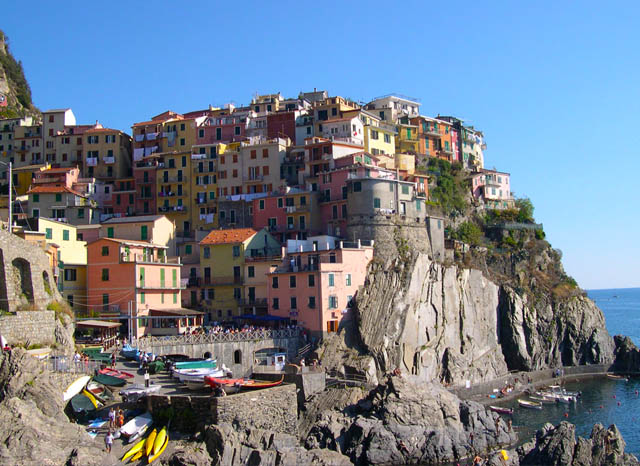
Vernazza: Perché Gli Americani Non Possono Resistere al Suo Fascino?
Vernazza: Why Do Americans Find It Irresistible?
Una Domanda Curiosa della Mia Zia Avventurosa: Dov’è Vernazza?
A Curious Question from My Adventurous Aunt: Where Is Vernazza?
L’altro giorno, mia zia di 84 anni, affascinata dai miei racconti di viaggi in Italia, mi ha chiesto se fossi mai stata nelle Cinque Terre in Liguria. “Dov’è, e perché agli americani piace così tanto?” si domandava. La sua domanda mi ha colto di sorpresa—non perché fosse insolita, ma perché mia zia, una viaggiatrice esperta che ha lavorato come hostess della TWA negli anni ’50, non aveva mai sentito parlare di Vernazza. La sua inesauribile curiosità verso nuovi luoghi non smette mai di stupirmi.
The other day, my 84-year-old aunt, captivated by my tales of Italian travels, asked me if I had ever been to the Cinque Terre in Liguria. “Where is it, and why do Americans love it so much?” she wondered. Her question caught me off guard—not because it was unusual, but because my aunt, a seasoned globetrotter who once worked as a TWA stewardess in the 1950s, had never heard of Vernazza. Her insatiable curiosity about new places never ceases to amaze me.
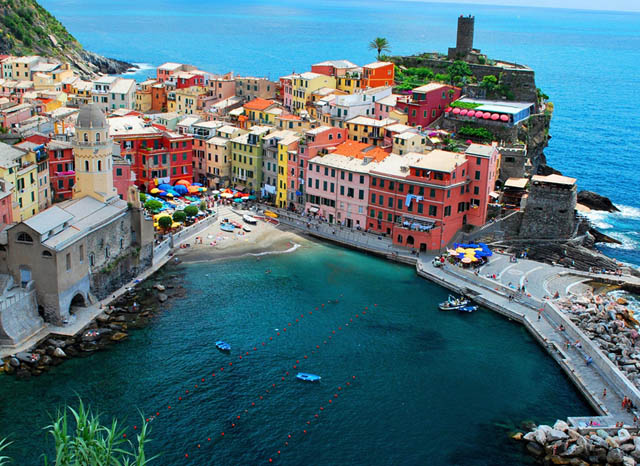
Sì! Sono andata a Vernazza!
Yes, I’ve been to Vernazza!
Le ho detto che sì, ero stata a Vernazza, più recentemente l’anno scorso, anche se la mia prima visita risale al 2004. Le ho spiegato come il villaggio mi abbia conquistata con la sua bellezza rustica e il suo terreno ripido e drammatico. Durante quella prima visita, avevo soggiornato in un semplice B&B, ma mi sono subito innamorata del villaggio di pescatori, che sembrava sospeso tra il cielo e il mare.
I told her that, yes, I had visited Vernazza, most recently the year before, though my first trip there was in 2004. I explained how the village charmed me with its rustic beauty and dramatic, steep terrain. I stayed in a simple B&B during that initial visit but was immediately smitten by the fishing village, which seemed precariously suspended between the sky and the sea.
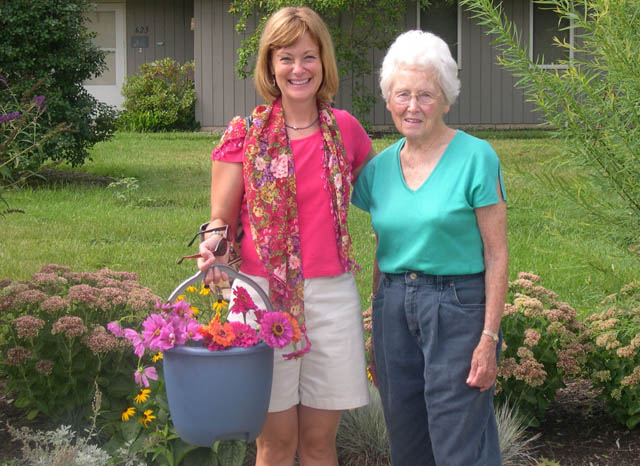
Perché agli americani piacciono le Cinque Terre?
Why do Americans adore the Cinque Terre?
Credo sia per la loro semplicità incantevole—un mix perfetto tra terra e mare che sembra unico e irraggiungibile nel nostro paese. Le case vivaci e colorate delle Cinque Terre sembrano piccoli gioielli incastonati tra le colline e il mare, una bellezza che richiama i visitatori come il canto di una sirena.
I think it’s because these villages offer an enchanting simplicity—an effortless blend of land and sea that feels completely unlike anything we have in the U.S. The vibrant, colorful houses of the Cinque Terre look like tiny jewels scattered between the hills and the ocean, their beauty drawing visitors like a siren’s call.
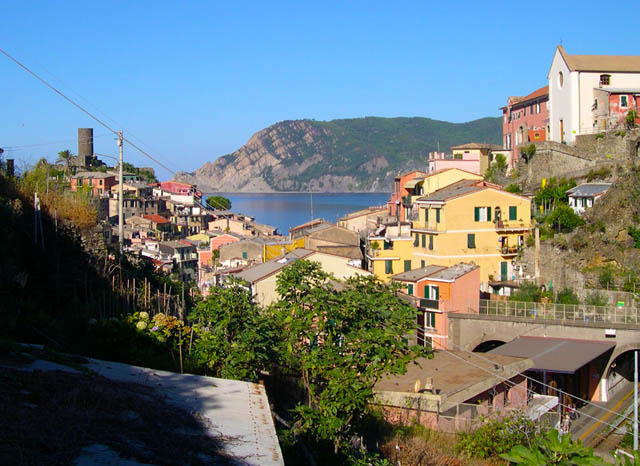
Vernazza: Un Villaggio Magico nelle Cinque Terre
Vernazza: A Magical Village in the Cinque Terre
Vernazza è un piccolo villaggio situato lungo la costa nord-occidentale della Liguria, con Genova a nord e Pisa a sud. Prima dell’arrivo delle ferrovie, i villaggi delle Cinque Terre erano accessibili solo via mare, e il loro isolamento contribuiva al loro fascino. Oggi, le Cinque Terre sono un parco nazionale protetto, con sentieri panoramici e acque cristalline che incantano visitatori da tutto il mondo.
Vernazza is a small village tucked along Italy’s northwestern Ligurian coast, with Genoa to the north and Pisa to the south. Before the advent of railways, the villages of the Cinque Terre were accessible only by sea, their remoteness adding to their mystique. Today, the Cinque Terre is a protected national park, complete with scenic hiking trails and crystal-clear waters that captivate visitors from around the world.
L’avventura di visitare Vernazza e gli altri villaggi—Manarola, Corniglia, Riomaggiore e Monterosso—risuona con lo spirito pionieristico degli americani. Amiamo la sfida di raggiungere questi luoghi nascosti, ricompensati da panorami mozzafiato, spiagge tranquille ed escursioni in barca. E, naturalmente, nessuna visita è completa senza gustare frutti di mare freschi e pasta sotto ombrelloni colorati, con il mare scintillante sullo sfondo.
The adventure of visiting Vernazza and the other villages—Manarola, Corniglia, Riomaggiore, and Monterosso—resonates with Americans’ pioneering spirit. We love the challenge of reaching these tucked-away places, rewarded by breathtaking views, quiet beaches, and boat excursions. And of course, no visit is complete without savoring fresh seafood and pasta under colorful umbrellas, with the sea shimmering nearby.
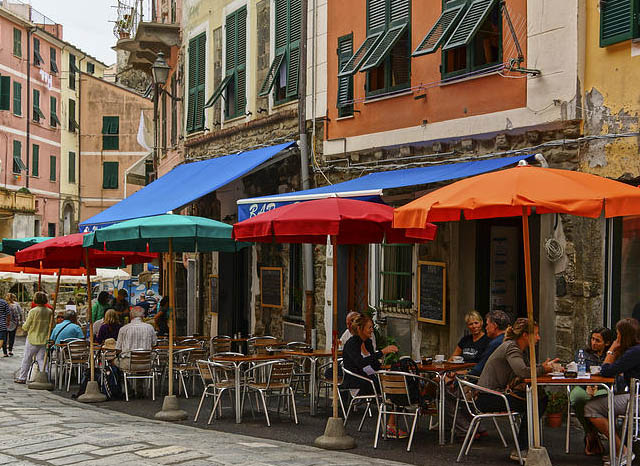
La Mia Esperienza a Vernazza
My Experience in Vernazza
Durante il mio soggiorno, ho percorso i sentieri panoramici, navigato nelle acque cristalline e cenato in affascinanti ristoranti sul lungomare. Ho alloggiato in una rustica cabina sulla collina, con un tetto piatto che fungeva da terrazza. Ogni mattina, mi svegliavo presto per guardare il sole sorgere e illuminare il villaggio, godendomi quei momenti di tranquillità mentre il paese si animava. Di sera, mi riunivo con altri viaggiatori sulla terrazza per un bicchiere di vino e un po’ di formaggio, prima di scendere lungo i ripidi sentieri verso il villaggio per cenare.
During my stay, I hiked the scenic trails, sailed the sparkling waters, and dined at charming waterfront restaurants. I lodged in a rustic hillside cabin with a flat roof that doubled as a terrace. Each morning, I’d wake early to watch the sun rise and illuminate the village, savoring those tranquil moments as the town came alive. In the evenings, I gathered with fellow travelers on the terrace for wine and cheese before heading down the steep paths to the village for dinner.
È stata una vera fuga nel cuore della bellezza italiana—un luogo che sembra senza tempo e magico. Quando ho finito di descrivere Vernazza a mia zia, lei ha sorriso, soddisfatta nella sua curiosità, ma con lo spirito avventuroso ancora acceso.
It was a true escape into the heart of Italian beauty—a place that feels timeless and magical. When I finished describing Vernazza to my aunt, she smiled, her curiosity satisfied but her adventurous spirit ignited.
Non Mi sorprende che, ora a 88 anni, mia zia stia pensando di visitare Vernazza l’anno prossimo. Alcuni sogni, a quanto pare, non svaniscono mai.
Not surprisingly, my now 88-year-old aunt is considering a visit to Vernazza next year. Some dreams, it seems, never fade.

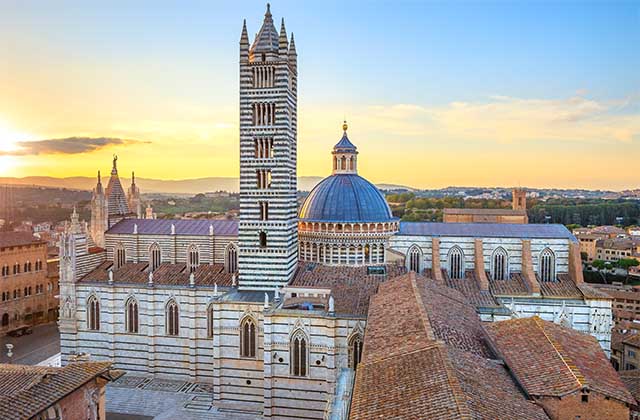









Ciao Melissa!
Anch’io sono stata spesso alle cinque terre.
Sono molto particolari.
La prima foto che hai inserito in questo articolo e’ Manarola.
Penso sia il borgo più caratteristico, con le sue case arroccate sulla collina.
A presto!
I often have been to the cinque terre me too.
They are very particular.
The first picture you’ve added to this article is about Manarola.
I think is the most typical village with its houses perched on the hill.
The translation is correct?!
Ciao! 😉
Hai ragione Patty, la prima foto e di Manarola. Ho fatto la foto me stessa quando eravamo la’. Abbiamo camminata il sentiero da Manarola al prossimo villaggio perche’ la distanza era il piu’ breve di tutti! 😉
The translation is good…here are some tiny corrections:
I too have been to the cinque terre many times.
It is very unique.
The first picture you’ve added to this article is of Manarola.
I think it is the most typical village with its’ houses perched on the hill. (perfetto!)
(nonostante in Italiano le cinque terre siano plurale…in inglese e’ singolare…the cinque terre, it is unique.)
Ciao Melissa!
Mi suona veramente bellissimo. Non vedo l’ora di vedere Cinque Terre con i miei propri occhi. Sarà il penultimo posto dove vado, all’inizio dell’agosto. L’ho messo sul mio itinerario per 3 notti e penso di camminare fra un paio dei paesi. Dovrò fare tante foto! 🙂
Thank you Melissa for your corrections!
@Chris:
un sentiero bellissimo da fare è quello tra Manarola e Rio Maggiore chiamato anche “via dell’amore”.
Complimenti anche a te per l’italiano! 😉
Grazie, Patty! Via dell’amore, eh?! Meglio che io mi trovo una bella ragazza italiana 😉
Hihi, grazie Patty. Piacere di conoscerti 🙂
@Chris:
penso che non avrai problemi a trovare unabella ragazza italiana 😉
Ah, ti consiglio la via dell’amore di sera/notte perchè illuminata è piu’ suggestiva!
Ciao 😉
Piacere mio Chris!
😉
ben scritto